- The bullfight
- The Scene. Different locations in a bullring
- The Scene The Timing of the corrida
- The Actors. El paseíllo (The Parade)
- The actors. El torero or matador (Bullfighter)
- The actors. Los subalternos (Secondary Bullfighters), La cuadrilla, Mozo de espadas
- - La cuadrilla: Is the team –or troupe- of the matador. In a normal corrida (those in which six bulls are killed by three matadors) every matador is assisted by two picadors and three secondary bullfighters.
- - In a mano a mano (a corrida in which only two matadors participate) the cuadrilla needs to be enlarged with an extra subalterno, to reach the four, and an extra picador, to reach three.
- In a corrida en solitario (with only one matador) the bullfighter needs to be assisted by two more cuadrillas apart from his own.
- - Mozo de espadas: Probably the most unknown actor of the bullfight, but an important one. He is the one who supports and helps the matador. His role consists in bringing the diestro all the tools he might need during the corrida (swords, cape, muleta, montera, or killing knife) from the callejón. He is also in charge of dressing the matador and organize his trips and those of the cuadrilla.
- The actors. The picador
- The actors. Mulillas (Dragging Mules)
- The Actors. Alguacilillos (The Sheriffs)
- The actors. The President
- The actors. The Bullfighting Bull
- La faena (The Work) La suerte de capote (The Cape Stage)
- La faena (The Work) Tercio de varas (Stage of Pikes)
- La faena (The Work) Tercio de banderillas (Little Harpoons Stage)
How much do you now about bulls?
Bullfighting is an art and also a ritual. It is has its own jargon and is plentiful of details and variations. Only by knowing and understanding all its particularities would the spectator truly appreciate this ancient show.
SERVITORO is committed to make easier for foreigners to understand and appreciate the corrida. For this reason this brochure has been written in English. Some of the terms related to this art are obviously impossible to translate. In those cases we have endeavored to provide an approximate translation and gone deeper in explaining the concept.
The Scene
The Actors
The faena (Work)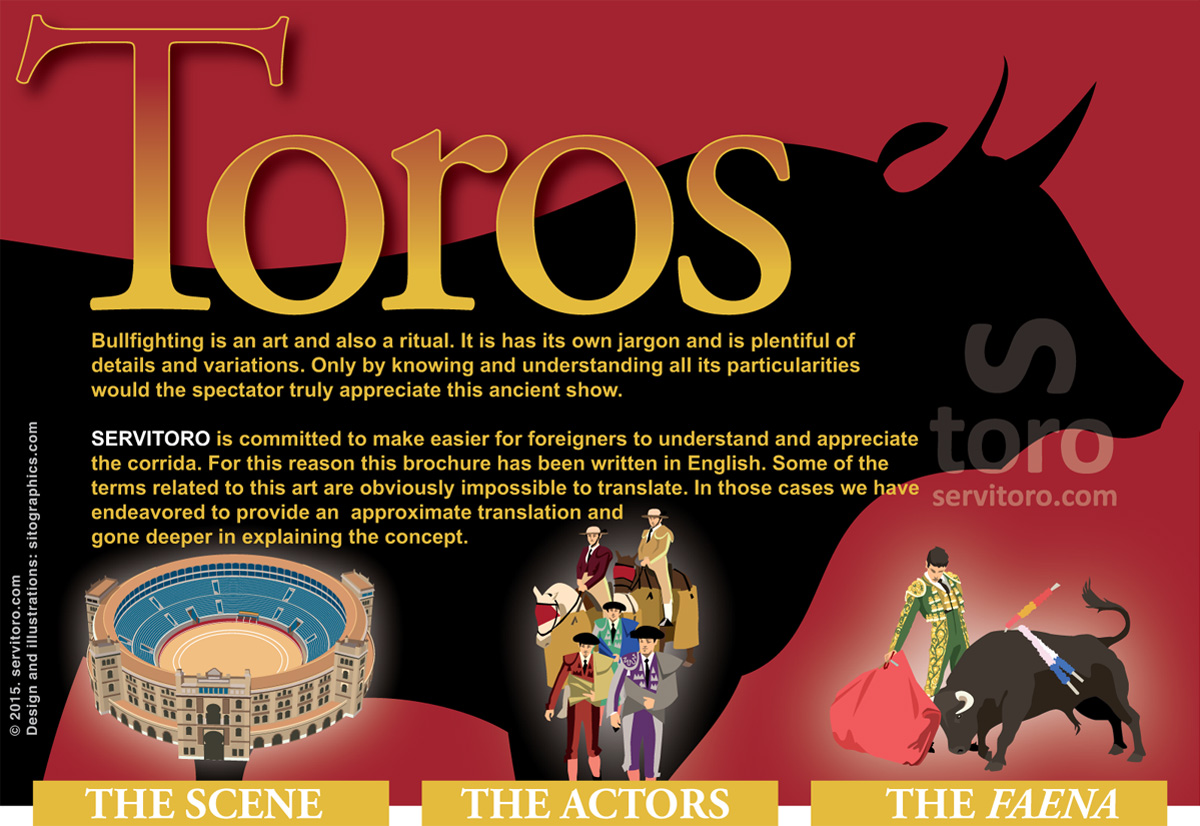
Different locations in a bullring
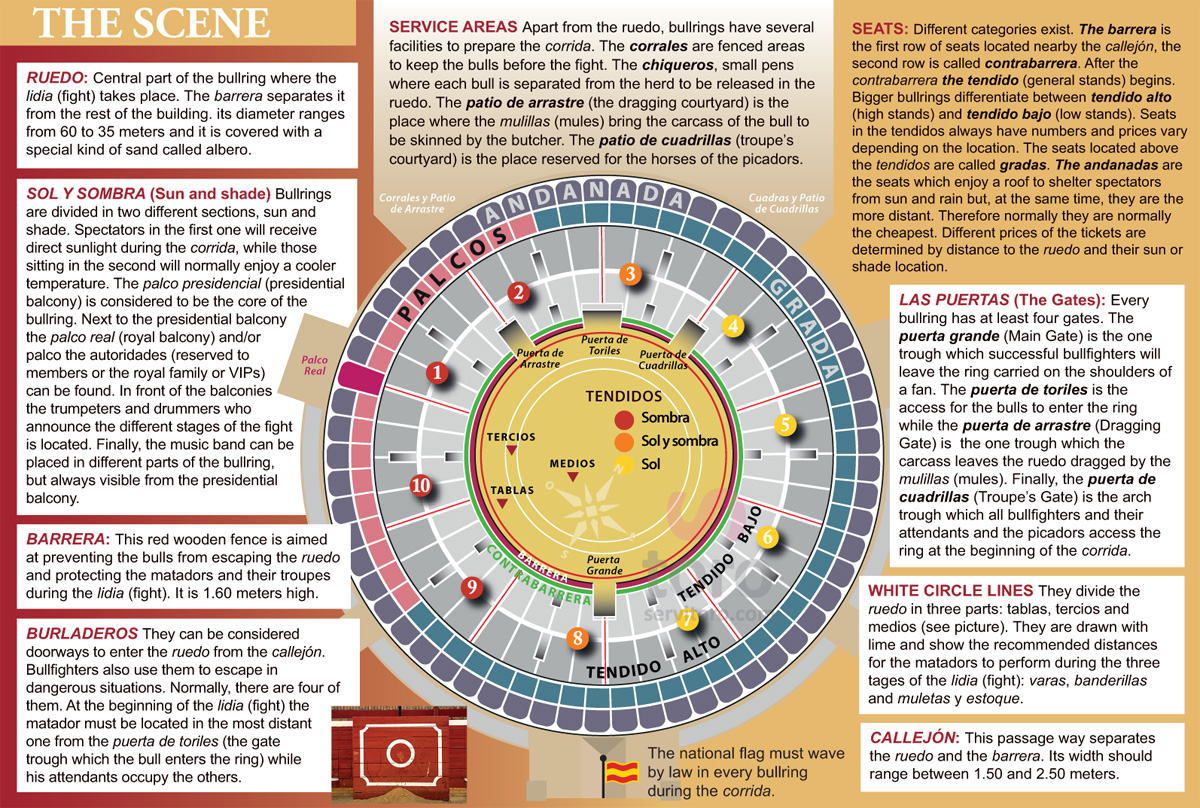
Ruedo
Central part of the bullring where the lidia (fight) takes place. The barrera separates it from the rest of the building. its diameter ranges from 60 to 35 meters and it is covered with a special kind of sand called albero.
Sol y sombra (Sun and shade)
Bullrings are divided in two different sections, sun and shade. Spectators in the first one will receive direct sunlight during the corrida, while those sitting in the second will normally enjoy a cooler temperature. The palco presidencial (presidential balcony) is considered to be the core of the bullring. Next to the presidential balcony the palco real (royal balcony) and/or palco the autoridades (reserved to members or the royal family or VIPs) can be found. In front of the balconies the reloj de clarineros y timbaleros (clock of trumpeters and drummers who announce the different stages of the fight) is located. Finally, the music band can be placed in different parts of the bullring, but always visible from the presidential balcony.
Barrera
This red wooden fence is aimed at preventing the bulls from escaping the ruedo and protecting the matadors and their troupes during the lidia (fight). It is 1.60 meters high
Burladeros
They can be considered doorways to enter the ruedo from the callejón. Bullfighters also use them to escape in dangerous situations. Normally, there are four of them. At the beginning of the lidia (fight) the matador must be located in the most distant one from the puerta de toriles (the gate trough which the bull enters the ring) while his attendants occupy the others.
Zonas de servicio (Service Areas)
Apart from the ruedo, bullrings have several facilities to prepare the corrida. The corrales are fenced areas to keep the bulls before the fight. The chiqueros, small pens where each bull is separated from the herd to be released in the ruedo. The patio de arrastre (the dragging courtyard) is the place where the mulillas (mules) bring the carcass of the bull to be skinned by the butcher. The patio de cuadrillas (troupe’s courtyard) is the place reserved for the horses of the picadors.
Seats
Different categories exist. The barrera is the first row of seats located nearby the callejón, the second row is called contrabarrera. After the contrabarrera the tendido (general stands) begins. Bigger bullrings differentiate between tendido alto (high stands) and tendido bajo (low stands). Seats in the tendidos always have numbers and prices vary depending on the location. The seats located above the tendidos are called gradas. The andanadas are the seats which enjoy a roof to shelter spectators from sun and rain but, at the same time, they are the more distant. Therefore normally they are normally the cheapest. Different prices of the tickets are determined by distance to the ruedo and their sun or shade location.
Las puertas (the gates)
Every bullring has at least four gates. The puerta grande (Main Gate) is the one trough which successful bullfighters will leave the ring carried on the shoulders of a fan. The puerta de toriles is the access for the bulls to enter the ring while the puerta de arrastre (Dragging Gate) is the one trough which the carcass leaves the ruedo dragged by the mulillas (mules). Finally, the puerta de cuadrillas (Troupe’s Gate) is the arch trough which all bullfighters and their attendants and the picadors access the ring at the beginning of the corrida.
White circle lines
They divide the ruedo in three parts: tablas, tercios and medios (see picture). They are drawn with lime and show the recommended distances for the matadors to perform during the three stages of the lidia (fight): varas, banderillas and muletas y estoque.
Callejón
This passage way separates the ruedo and the barrera. Its width should range between 1.50 and 2.50 meters.
· The national flag must wave by law in every bullring during the corrida
The Timing of the corrida
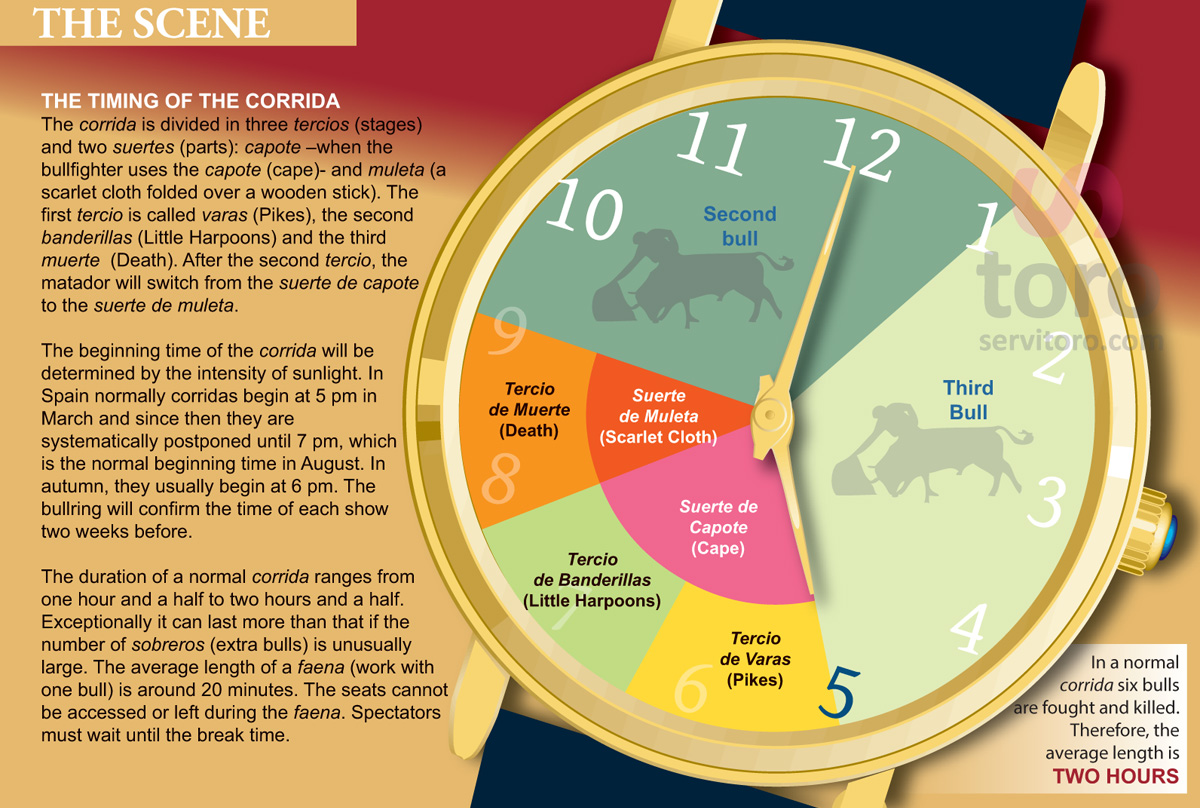
The corrida is divided in three tercios (stages) and two suertes (parts): capote –when the bullfighter uses the capote (cape)- and muleta (a scarlet cloth folded over a wooden stick). The first tercio is called varas (Pikes), the second banderillas (Little Harpoons) and the third muerte (Death). After the second tercio, the matador will switch from the suerte de capote to the suerte de muleta.
The beginning time of the corrida will be determined by the intensity of sunlight. In Spain normally corridas begin at 5 pm in March and since then they are systematically postponed until 7 pm, which is the normal beginning time in August. In autumn, they usually begin at 6 pm. The bullring will confirm the time of each show two weeks before.
The duration of a normal corrida ranges from one hour and a half to two hours and a half. Exceptionally it can last more than that if the number of sobreros (extra bulls) is unusually large. The average length of a faena (work with one bull) is around 20 minutes. The seats cannot be accessed or left during the faena. Spectators must wait until the break time.

Is the beginning of the corrida. Bullfighters, their troupes and all people who work in the bullfight march from the puerta de cuadrillas (Gate of the Troupes) to the palco presidencial (presidential balcony). The order is very strict. Once the parade is finished, the participants wave their hands at the president, wait one minute in silence and then wave at the audience.
Monosabios (Assistants) They help the picador (the man on a horse armed with a pike) when he is fighting the bull
Mulilleros (Muleteers) Helped by three mules, they drag the carcass of the bull out of the bullring after the faena
Areneros (Sandmen) They take care of the sand of the ruedo, keeping it in a good condition for the lidia (fight)
Picadors (Riders armed with a pike) Two of them work for each matador. During the paseíllo, they follow the same order than secondary bullfighters
Subalternos (Secondary Bullfighters) Those working for the oldest matador occupy the first row, then come those working for the second oldest and finally those working for the youngest
Matadores (Bullfighters) They occupy the first row in the parade. The oldest one is located on the left side and the youngest in the middle. If a matador is fighting bulls for the first time in that bullring, he will carry his montera (hat) in his hands during the paseíllo.
Alguacilillos (Sheriffs) They drive the parade to the presidential balcony and after that they spin around the ruedo on their horses to verify that everything is prepared for the bullfight to begin.
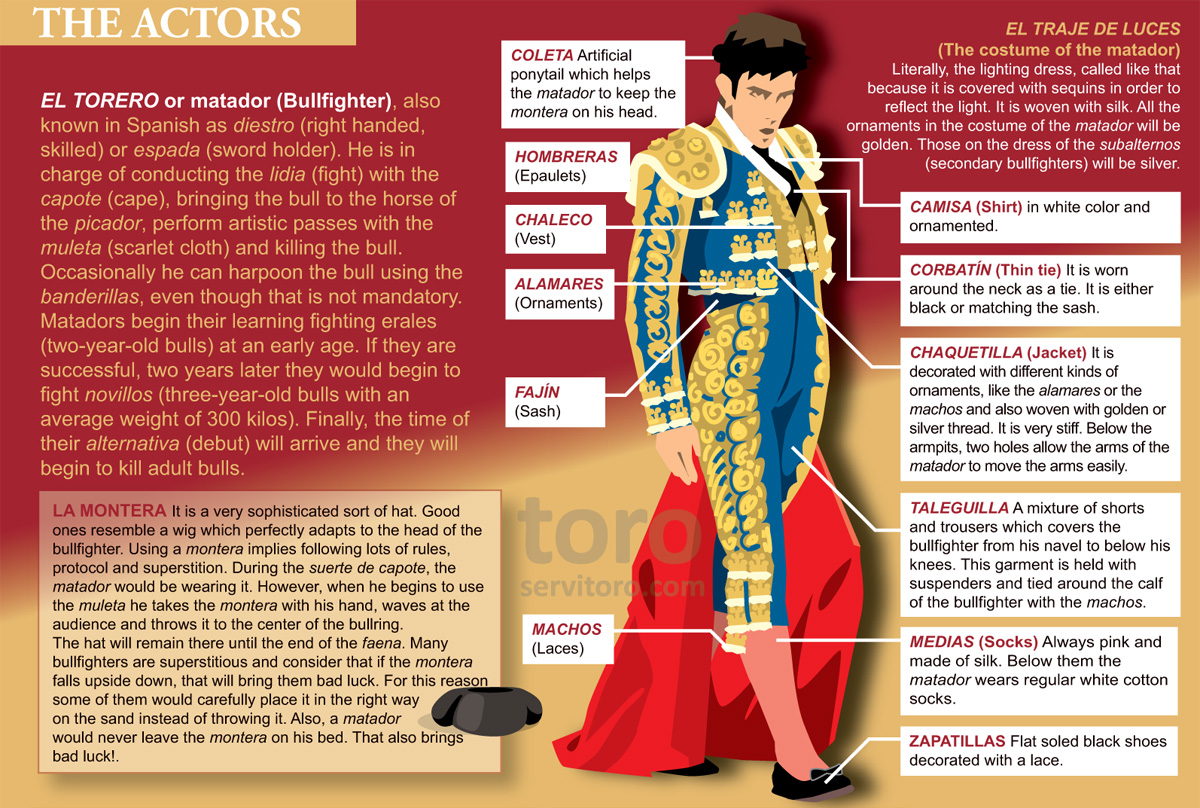
El torero or matador (Bullfighter), also known in Spanish as diestro (right handed, skilled) or espada (sword holder). He is in charge of conducting the lidia (fight) with the capote (cape), bringing the bull to the horse of the picador, perform artistic passes with the muleta (scarlet cloth) and killing the bull. Occasionally he can harpoon the bull using the banderillas, even though that is not mandatory. Matadors begin their learning fighting erales (two-year-old bulls) at an early age. If they are successful, two years later they would begin to fight novillos (three-year-old bulls with an average weight of 300 kilos). Finally, the time of their alternativa (debut) will arrive and they will begin to kill adult bulls.
La montera
It is a very sophisticated sort of hat. Good ones resemble a wig which perfectly adapts to the head of the bullfighter.
Using a montera implies following lots of rules, protocol and superstition. During the suerte de capote, the matador would be wearing it. However, when he begins to use the muleta he takes the montera with his hand, waves at the audience and throws it to the center of the bullring. The hat will remain there until the end of the faena. Many bullfighters are superstitious and consider that if the montera falls upside down, that will bring them bad luck. For this reason some of them would carefully place it in the right way on the sand instead of throwing it. Also, a matador would never leave the montera on his bed. That also brings bad luck!
Coleta
Artificial ponytail which helps the matador to keep the montera on his head
Hombreras (Epaulets)
Chaleco (Vest)
Alamares (Ornaments)
Fajín (Sash)
Machos (Laces)
El traje de luces (The costume of the matador)
Literally, the lighting dress, called like that because it is covered with sequins in order to reflect the light. It is woven with silk. All the ornaments in the costume of the matador will be golden. Those on the dress of the subalternos (secondary bullfighters) will be silver.
Camisa (Shirt) in white color and ornamented
Corbatín (Thin tie) It is worn around the neck as a tie. It is either black or matching the sash
Chaquetilla (Jacket) It is decorated with different kinds of ornaments, like the alamares or the machos and also woven with golden or silver thread. It is very stiff. Below the armpits, two holes allow the arms of the matador to move the arms easily.
Taleguilla: A mixture of shorts and trousers which covers the bullfighter from his navel to below his knees. This garment is held with suspenders and tied around the calf of the bullfighter with the machos.
Medias (Socks): Always pink and made of silk. Below them the matador wears regular white cotton socks.
Zapatillas: Flat soled black shoes decorated with a lace.
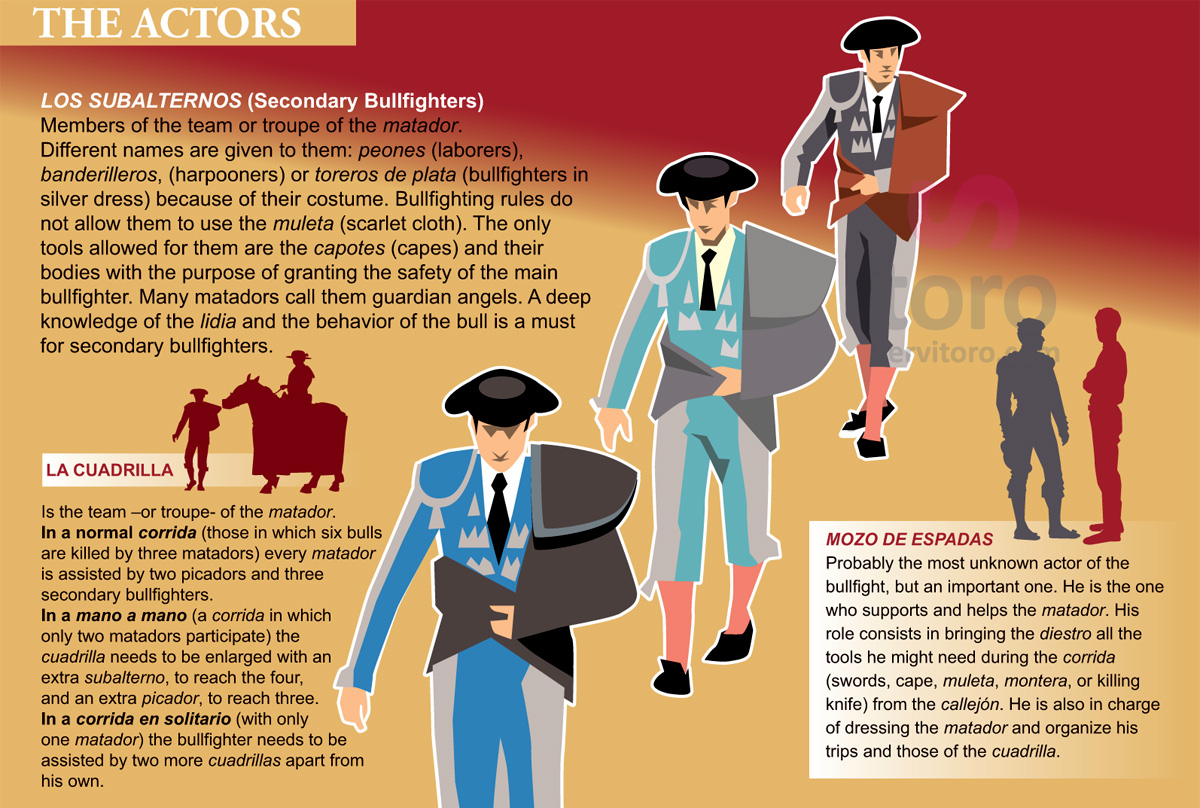
Los subalternos (Secondary Bullfighters) Members of the team or troupe of the matador. Different names are given to them: peones (laborers), banderilleros, (harpooners) or toreros de plata (bullfighters in silver dress) because of their costume. Bullfighting rules do not allow them to use the muleta (scarlet cloth). The only tools allowed for them are the capotes (capes) and their bodies with the purpose of granting the safety of the main bullfighter. Many matadors call them guardian angels. A deep knowledge of the lidia and the behavior of the bull is a must for secondary bullfighters.
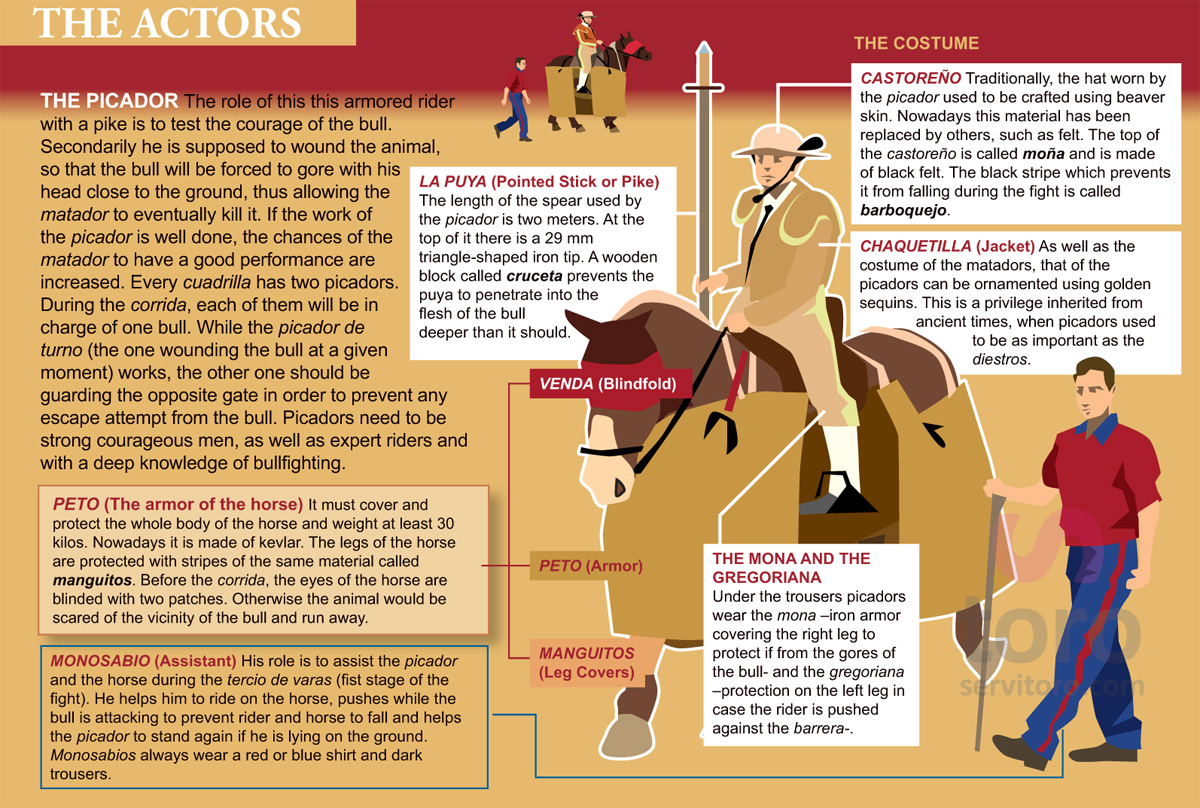
The role of this this armored rider with a pike is to test the courage of the bull. Secondarily he is supposed to wound the animal, so that the bull will be forced to gore with his head close to the ground, thus allowing the matador to eventually kill it. If the work of the picador is well done, the chances of the matador to have a good performance are increased. Every cuadrilla has two picadors. During the corrida, each of them will be in charge of one bull. While the picador de turno (the one wounding the bull at a given moment) works, the other one should be guarding the opposite gate in order to prevent any escape attempt from the bull. Picadors need to be strong courageous men, as well as expert riders and with a deep knowledge of bullfighting.
Peto (The armor of the horse)
It must cover and protect the whole body of the horse and weight at least 30 kilos. Nowadays it is made of kevlar. The legs of the horse are protected with stripes of the same material called manguitos. Before the corrida, the eyes of the horse are blinded with two patches. Otherwise the animal would be scared of the vicinity of the bull and run away.
Monosabio (Assistant)
His role is to assist the picador and the horse during the tercio the varas (fist stage of the fight). He helps him to ride on the horse, pushes while the bull is attacking to prevent rider and horse to fall and helps the picador to stand again if he is lying on the ground. Monosabios always wear a red or blue shirt and dark trousers.
La puya (Pointed Stick or Pike)
The length of the spear used by the picador is two meters. At the top of it there is a 29 mm triangle-shaped iron tip. A wooden block called cruceta prevents the puya to penetrate into the flesh of the bull deeper than it should.
Venda (Blindfold)
Peto (Armor)
Manguitos (Leg Covers)
The costume
Castoreño: Traditionally, the hat worn by the picador used to be crafted using beaver skin. Nowadays this material has been replaced by others, such as felt. The top of the castoreño is called moña and is made of black felt. The black stripe which prevents it from falling during the fight is called barboquejo.
Chaquetilla (Jacket). As well as the costume of the matadors, that of the picadors can be ornamented using golden sequins. This is a privilege inherited from ancient times, when picadors used to be as important as the diestros.
The mona and the gregoriana
Under the trousers picadors wear the mona –iron armor covering the right leg to protect if from the gores of the bull- and the gregoriana –protection on the left leg in case the rider is pushed against the barrera-.
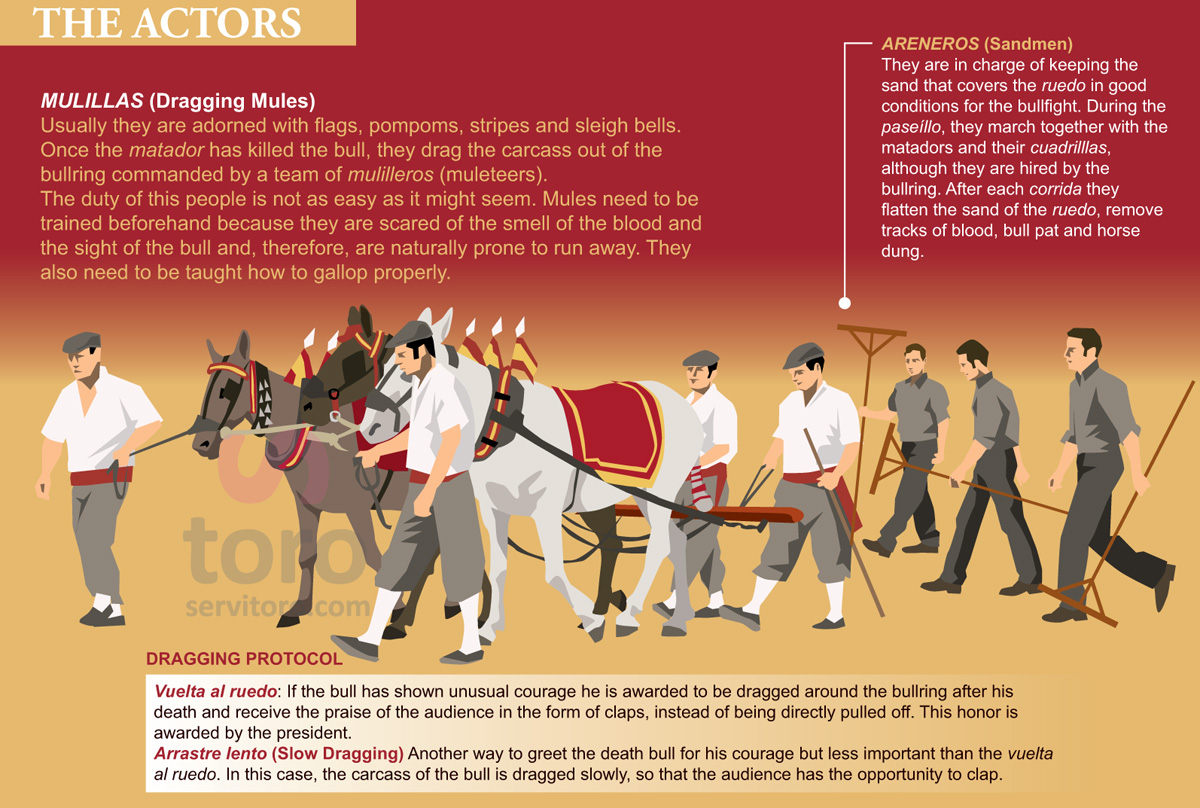
Usually they are adorned with flags, pompoms, stripes and sleigh bells. Once the matador has killed the bull, they drag the carcass out of the bullring commanded by a team of mulilleros (muleteers).
The duty of this people is not as easy as it might seem. Mules need to be trained beforehand because they are scared of the smell of the blood and the sight of the bull and, therefore, are naturally prone to run away. They also need to be taught how to gallop properly.
Dragging Protocol
Vuelta al ruedo: If the bull has shown unusual courage he is awarded to be dragged around the bullring after his death and receive the praise of the audience in the form of claps, instead of being directly pulled off. This honor is awarded by the president.
Arrastre lento (Slow Dragging) Another way to greet the death bull for his courage but less important than the vuelta al ruedo. In this case, the carcass of the bull is dragged slowly, so that the audience has the opportunity to clap.
Areneros (Sandmen)
They are in charge of keeping the sand that covers the ruedo in good conditions for the bullfight. During the paseíllo, they march together with the matadors and their cuadrilllas, although they are hired by the bullring. After each corrida they flatten the sand of the ruedo, remove tracks of blood, bull pat and horse dung.
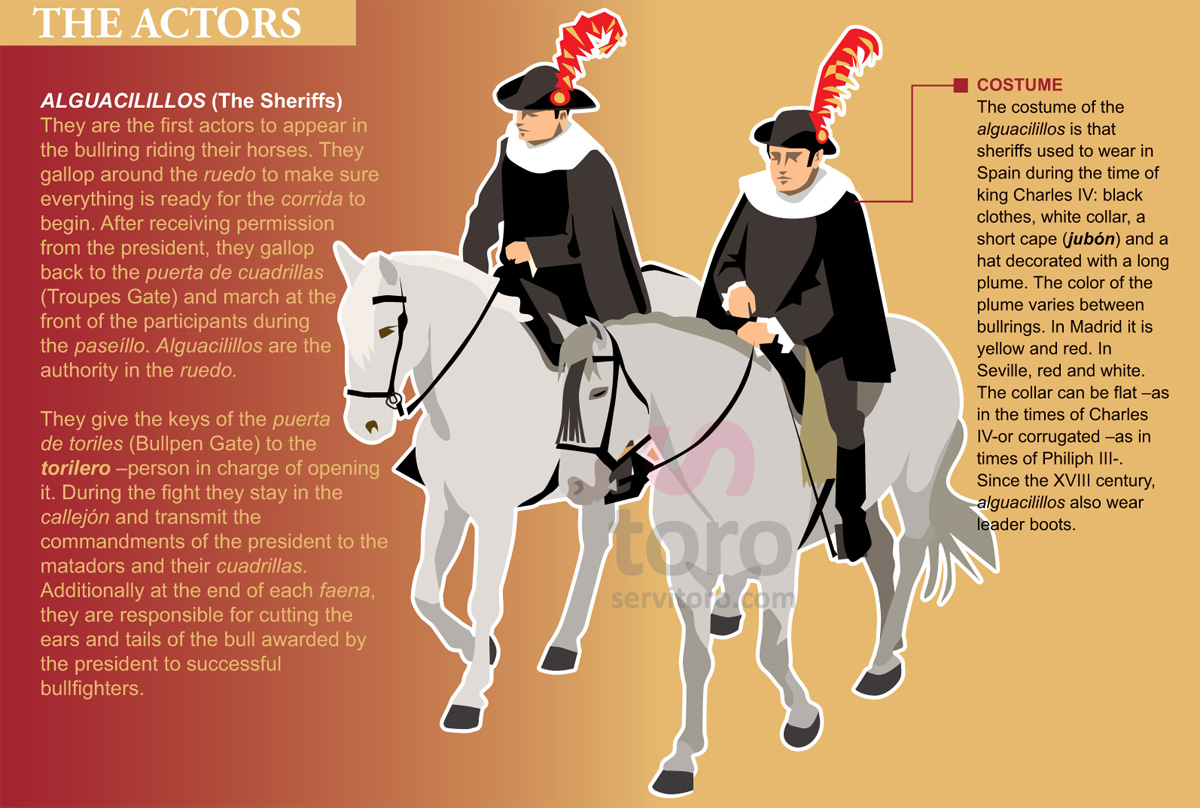
They are the first actors to appear in the bullring riding their horses. They gallop around the ruedo to make sure everything is ready for the corrida to begin. After receiving permission from the president, they gallop back to the puerta de cuadrillas (Troupes Gate) and march at the front of the participants during the paseíllo. Alguacilillos are the authority in the ruedo. They give the keys of the puerta de toriles (Bullpen Gate) to the torilero –person in charge of opening it. During the fight they stay in the callejón and transmit the commandments of the president to the matadors and their cuadrillas. Additionally at the end of each faena, they are responsible for cutting the ears and tails of the bull awarded by the president to successful bullfighters.
Costume
The costume of the alguacilillos is that sheriffs used to wear in Spain during the time of king Charles IV: black clothes, white collar, a short cape (jubón) and a hat decorated with a long plume. The color of the plume varies between bullrings. In Madrid it is yellow and red. In Seville, red and white. The collar can be flat –as in the times of Charles IV-or corrugated –as in times of Philiph III-. Since the XVIII century, alguacilillos also wear leader boots.
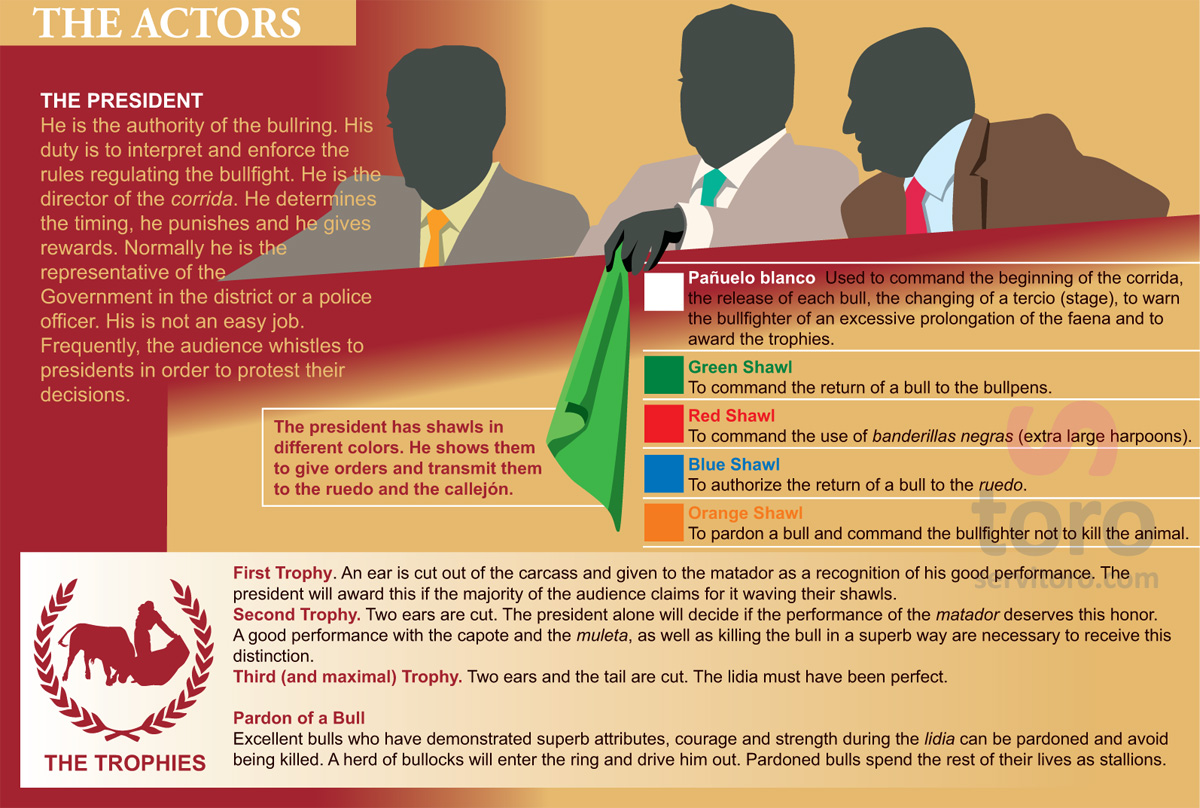
He is the authority of the bullring. His duty is to interpret and enforce the rules regulating the bullfight. He is the director of the corrida. He determines the timing, he punishes and he gives rewards. Normally he is the representative of the Government in the district or a police officer. His is not an easy job. Frequently, the audience whistles to presidents in order to protest their decisions.
The president has shawls in different colors. He shows them to give orders and transmit them to the ruedo and the callejón.
White Shawl
Used to command the beginning of the corrida, the release of each bull, the changing of a tercio (stage), to warn the bullfighter of an excessive prolongation of the faena and to award the trophies
Green Shawl
To command the return of a bull to the bullpens
Red Shawl
To command the use of banderillas negras (extra large harpoons)
Blue Shawl
To authorize the return of a bull to the ruedo
Orange Shawl
To pardon a bull and command the bullfighter not to kill the animal
The Trophies
First Trophy: An ear is cut out of the carcass and given to the matador as a recognition of his good performance. The president will award this if the majority of the audience claims for it waving their shawls.
Second Trophy:Two ears are cut. The president alone will decide if the performance of the matador deserves this honor. A good performance with the capote and the muleta, as well as killing the bull in a superb way are necessary to receive this distinction.
Third (and maximal) Trophy: Two ears and the tail are cut. The lidia must have been perfect.
Pardon of a Bull
Excellent bulls who have demonstrated superb attributes, courage and strength during the lidia can be pardoned and avoid being killed. A herd of bullocks will enter the ring and drive him out. Pardoned bulls spend the rest of their lives as stallions.
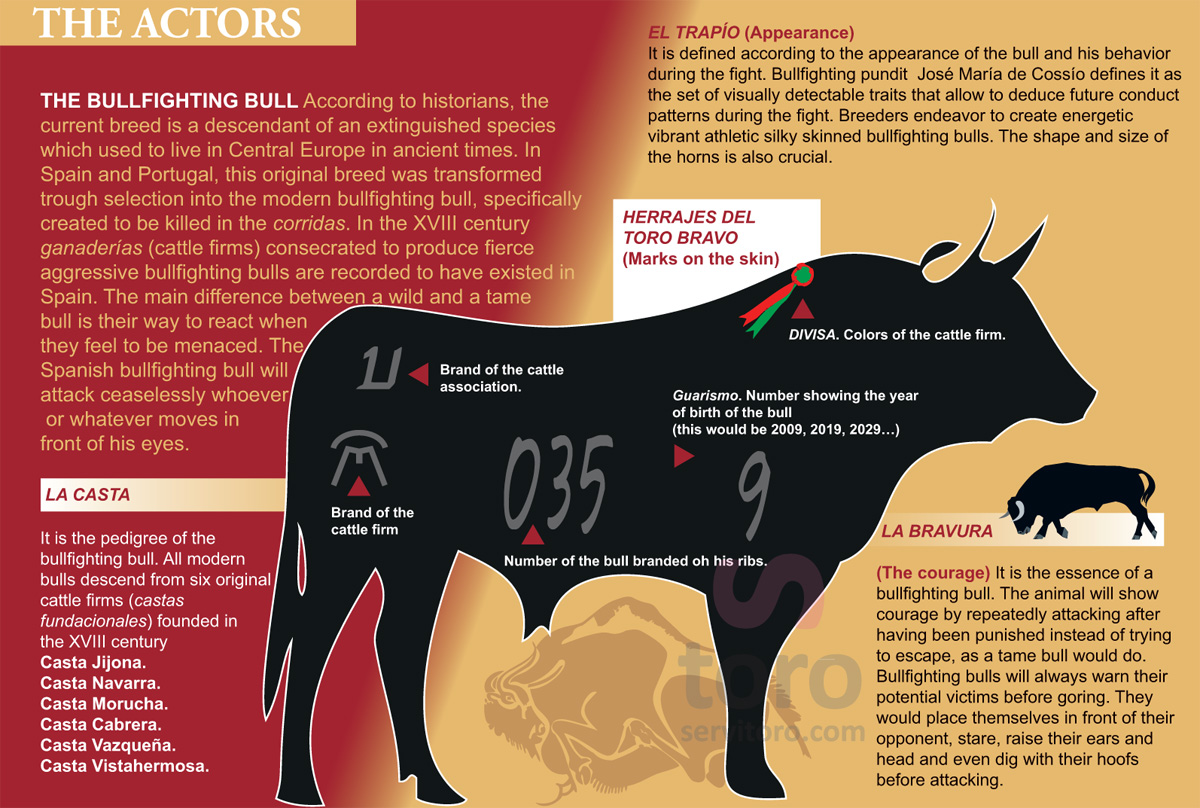
According to historians, the current breed is a descendant of an extinguished species which used to live in Central Europe in ancient times. In Spain and Portugal, this original breed was transformed trough selection into the modern bullfighting bull, specifically created to be killed in the corridas. In the XVIII century ganaderías (cattle firms) consecrated to produce fierce aggressive bullfighting bulls are recorded to have existed in Spain. The main difference between a wild and a tame bull is their way to react when they feel to be menaced. The Spanish bullfighting bull will attack ceaselessly whoever or whatever moves in front of his eyes.
La casta
It is the pedigree of the bullfighting bull. All modern bulls descend from six original cattle firms (castas fundacionales) founded in the XVIII century
Casta Jijona
Casta Navarra
Casta Morucha
Casta Cabrera
Casta Vazqueña
Casta Vistahermosa
El trapío (appearance)
It is defined according to the appearance of the bull and his behavior during the fight. Bullfighting pundit José María de Cossío defines it as the set of visually detectable traits that allow to deduce future conduct patterns during the fight. Breeders endeavor to create energetic vibrant athletic silky skinned bullfighting bulls. The shape and size of the horns is also crucial.
La bravura (the courage)
It is the essence of a bullfighting bull. The animal will show courage by repeatedly attacking after having been punished instead of trying to escape, as a tame bull would do. Bullfighting bulls will always warn their potential victims before goring. They would place themselves in front of their opponent, stare, raise their ears and head and even dig with their hoofs before attacking.
Herrajes del toro bravo (marks on the skin)
* Divisa: Colors of the cattle firm
* Brand of the cattle association
* Guarismo: Number showing the year of birth of the bull (this would be 2009, 2019, 2029…)
* Brand of the cattle firm
* Number of the bull branded oh his ribs
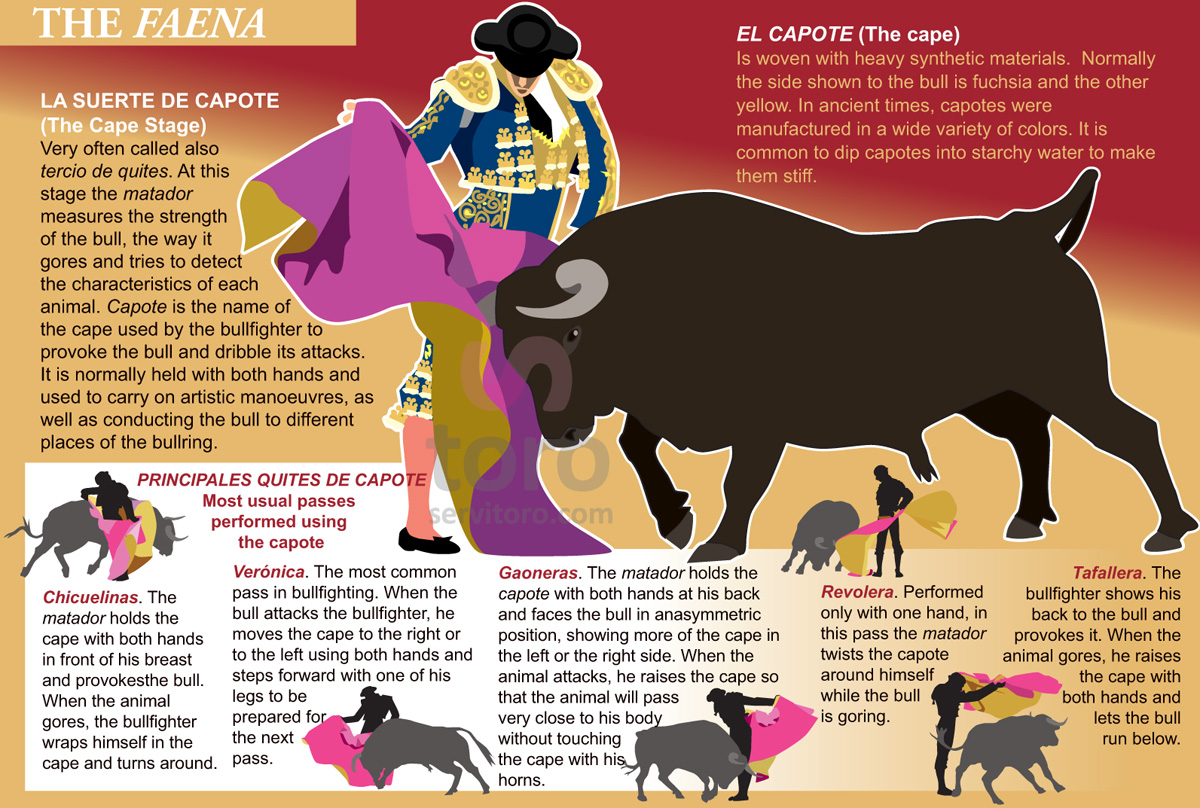
Very often called also tercio de quites. At this stage the matador measures the strength of the bull, the way it gores and tries to detect the characteristics of each animal. Capote is the name of the cape used by the bullfighter to provoke the bull and dribble its attacks. It is normally held with both hands and used to carry on artistic manoeuvres, as well as conducting the bull to different places of the bullring.
El capote (the cape)
Is woven with heavy synthetic materials. Normally the side shown to the bull is fuchsia and the other yellow. In ancient times, capotes were manufactured in a wide variety of colors. It is common to dip capotes into starchy water to make them stiff.
Principales quites de capote (Most usual passes performed using the capote)
Chicuelinas: The matador holds the cape with both hands in front of his breast and provokes the bull. When the animal gores, the bullfighter wraps himself in the cape and turns around
Verónica: The most common pass in bullfighting. When the bull attacks the bullfighter, he moves the cape to the right or to the left using both hands and steps forward with one of his legs to be prepared for the next pass.
Gaoneras: The matador holds the capote with both hands at his back and faces the bull in an asymmetric position, showing more of the cape in the left or the right side. When the animal attacks, he raises the cape so that the animal will pass very close to his body without touching the cape with his horns.
Revolera: Performed only with one hand, in this pass the matador twists the capote around himself while the bull is goring
Tafallera: The bullfighter shows his back to the bull and provokes it. When the animal gores, he raises the cape with both hands and lets the bull run below.
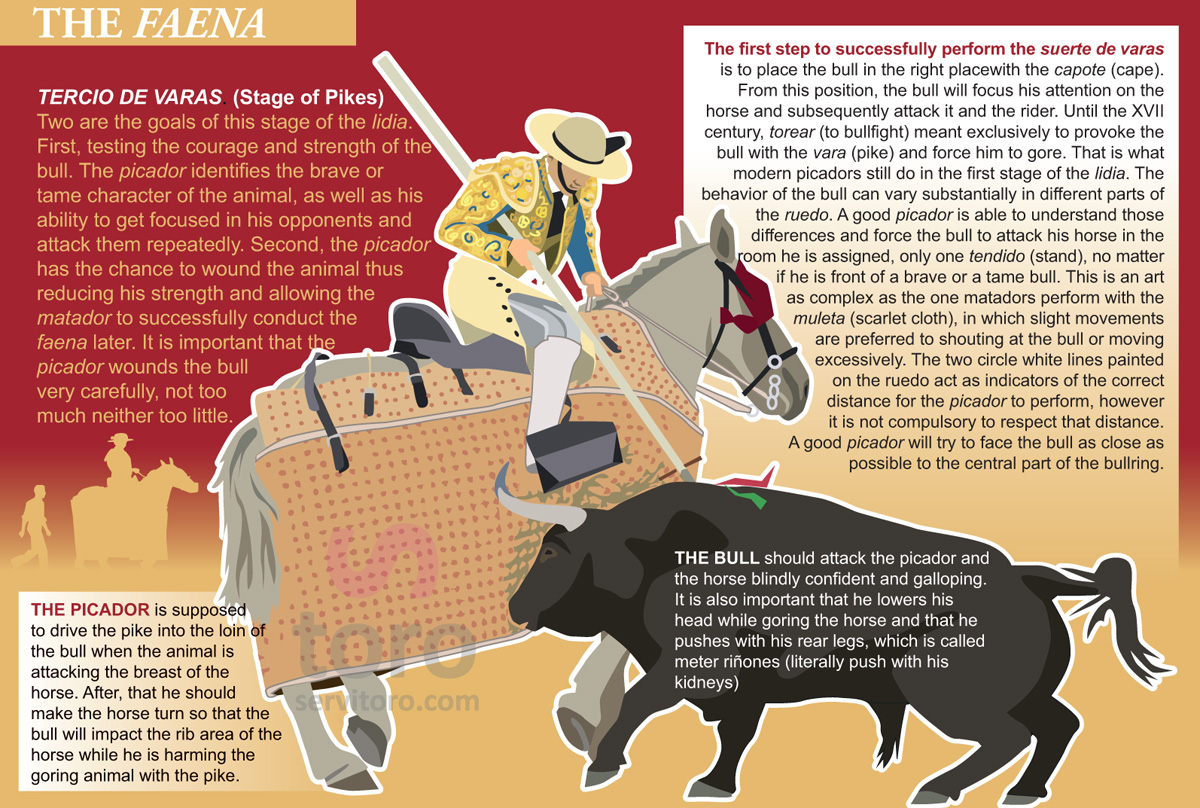
Tercio de varas (Stage of Pikes) Two are the goals of this stage of the lidia. First, testing the courage and strength of the bull. The picador identifies the brave or tame character of the animal, as well as his ability to get focused in his opponents and attack them repeatedly. Second, the picador has the chance to wound the animal thus reducing his strength and allowing the matador to successfully conduct the faena later. It is important that the picador wounds the bull very carefully, not too much neither too little.
Picador
The picador is supposed to drive the pike into the loin of the bull when the animal is attacking the breast of the horse. After, that he should make the horse turn so that the bull will impact the rib area of the horse while he is harming the goring animal with the pike.
The first step to successfully perform the suerte de varas is to place the bull in the right place with the capote (cape). From this position, the bull will focus his attention on the horse and subsequently attack it and the rider. Until the XVII century, torear (to bullfight) meant exclusively to provoke the bull with the vara (pike) and force him to gore. That is what modern picadors still do in the first stage of the lidia. The behavior of the bull can vary substantially in different parts of the ruedo. A good picador is able to understand those differences and force the bull to attack his horse in the room he is assigned, only one tendido (stand), no matter if he is front of a brave or a tame bull. This is an art as complex as the one matadors perform with the muleta (scarlet cloth), in which slight movements are preferred to shouting at the bull or moving excessively. The two circle white lines painted on the ruedo act as indicators of the correct distance for the picador to perform, however it is not compulsory to respect that distance. A good picador will try to face the bull as close as possible to the central part of the bullring.
The bull should attack the picador and the horse blindly confident and galloping. It is also important that he lowers his head while goring the horse and that he pushes with his rear legs, which is called meter riñones (literally push with his kidneys)
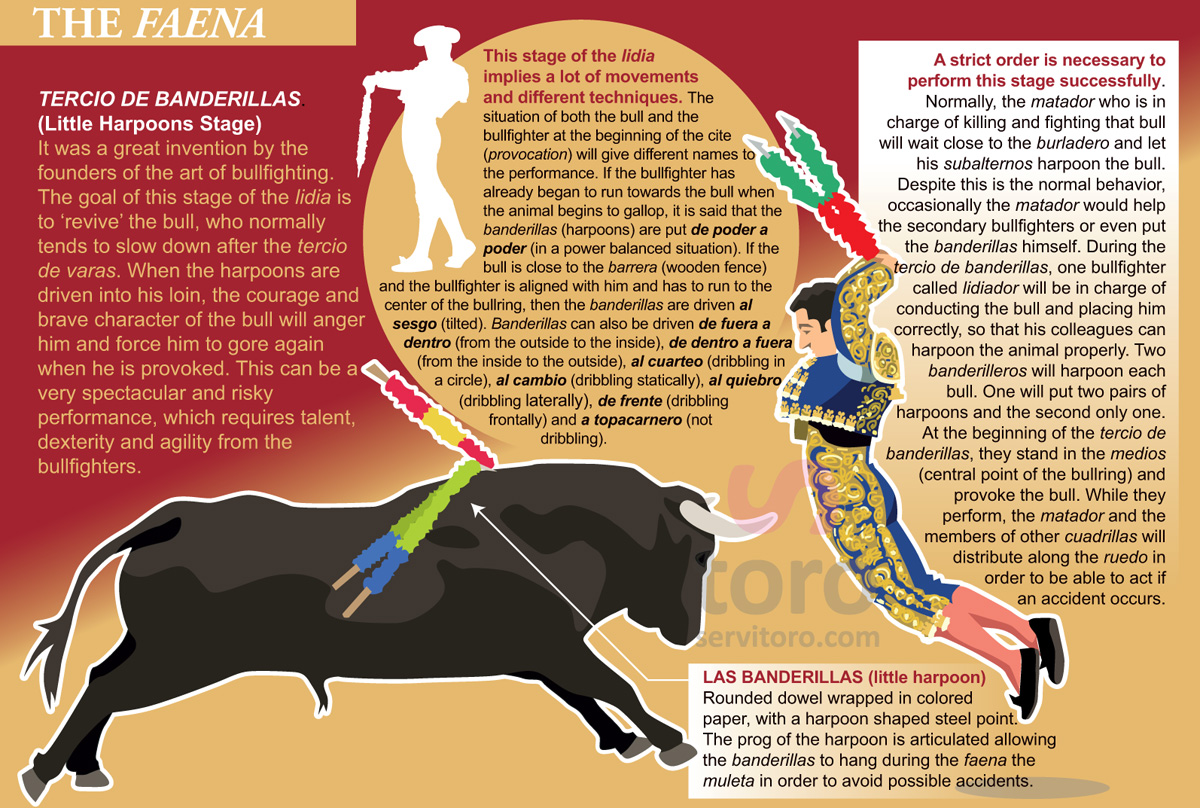
The Faena. 'Tercio de Banderillas'
It was a great invention by the founders of the art of bullfighting. The goal of this stage of the lidia is to ‘revive’ the bull, who normally tends to slow down after the tercio de varas. When the harpoons are driven into his loin, the courage and brave character of the bull will anger him and force him to gore again when he is provoked. This can be a very spectacular and risky performance, which requires talent, dexterity and agility from the bullfighters.
This stage of the lidia implies a lot of movements and different techniques. The situation of both the bull and the bullfighter at the beginning of the cite (provocation) will give different names to the performance. If the bullfighter has already began to run towards the bull when the animal begins to gallop, it is said that the banderillas (harpoons) are put de poder a poder (in a power balanced situation). If the bull is close to the barrera (wooden fence) and the bullfighter is aligned with him and has to run to the center of the bullring, then the banderillas are driven al sesgo (tilted). Banderillas can also be driven de fuera a dentro (from the outside to the inside), de dentro a fuera (from the inside to the outside), al cuarteo (dribbling in a circle), al cambio (dribbling statically), al quiebro (dribbling laterally), de frente (dribbling frontally) and a topacarnero (not dribbling).
A strict order is necessary to perform this stage successfully. Normally, the matador who is in charge of killing and fighting that bull will wait close to the burladero and let his subalternos harpoon the bull. Despite this is the normal behavior, occasionally the matador would help the secondary bullfighters or even put the banderillas himself. During the tercio de banderillas, one bullfighter called lidiador will be in charge of conducting the bull and placing him correctly, so that his colleagues can harpoon the animal properly. Two banderilleros will harpoon each bull. One will put two pairs of harpoons and the second only one. At the beginning of the tercio de banderillas, they stand in the medios (central point of the bullring) and provoke the bull. While they perform, the matador and the members of other cuadrillas will distribute along the ruedo in order to be able to act if an accident occurs.
The banderilla (little harpoon)
Rounded dowel wrapped in colored paper, with a harpoon shaped steel point. The prog of the harpoon is articulated allowing the banderillas to hang during the faena the muleta in order to avoid possible accidents.

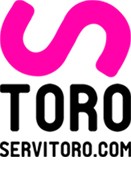


















 Copyright © Servitoro. All rights reserved. Web design:
Copyright © Servitoro. All rights reserved. Web design: 